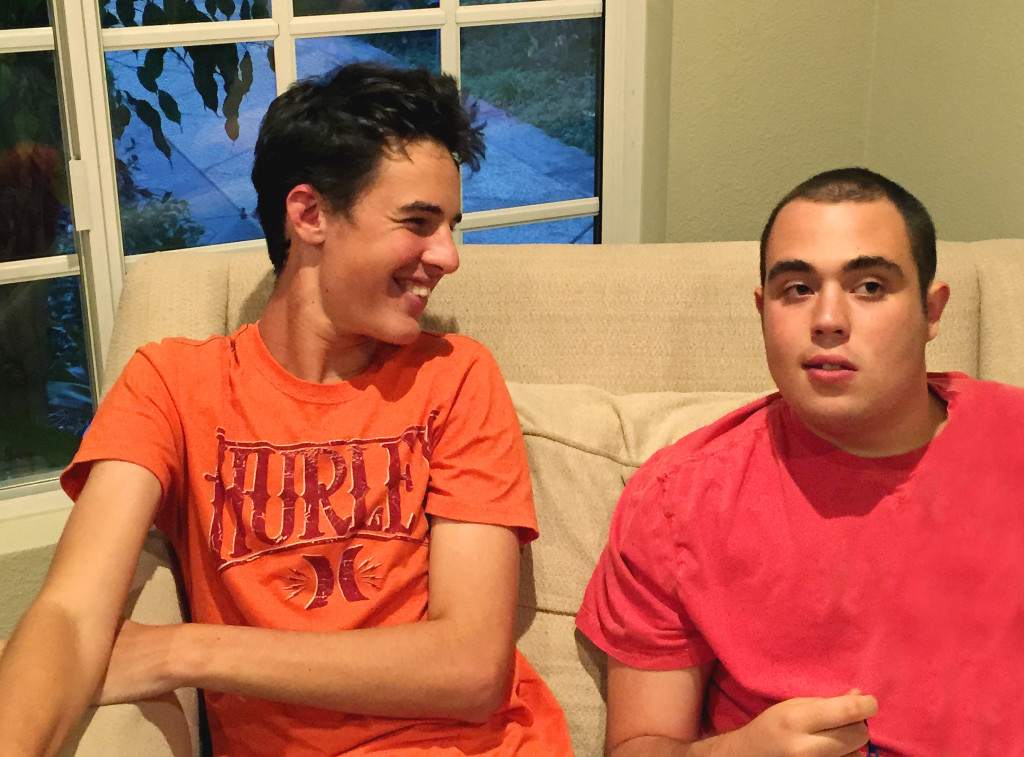Last year I was asked by two neuro-researchers to describe my mind/motor problems to be part of a scholarly research paper they were publishing in a neurology journal. My personal experiences helped support their clinical findings. In other words, their data was validated by my life experiences. Unfortunately, papers get rejected all the time in scientific journals. I believe and hope their findings will still be published, however my essay will not be included as the editors determined that what I wrote was too personal and unscientific for their venue (meaning not research based). This is true. My essay is not research based. It is biographical. My essay is merely a description of my life and struggles that I hoped would intrigue more researchers to look into motor issues and autism.
I figure, why waste a perfectly good essay? The editors suggested I find another venue to publish my essay and I decided that my blog is the perfect venue to share “Motor Difficulties in Severe Autism.”
Motor Difficulties in Severe Autism
by Ido Kedar
Most theories about severe autism that are used today by educators and other professionals are based on the premise that severe nonverbal autism is a learning problem with receptive and expressive language delay, low cognitive capacity, concrete thinking, lack of humor, lack of empathy, lack of theory of mind, and often even an absence in basic awareness of the surrounding world. The expressionless faces, inability to make eye contact, the sometimes bizarre looking self-stimulatory behavior, and the inability to speak can make intelligent people appear not to be. As a person with autism, this is deeply frustrating. When I meet strangers for the first time, they often presume I need baby talk because of my outer presentation. I cannot stop my neurological forces from camouflaging my real essence. Inside there is a person who thinks, feels, jokes, and has a lot to say. On the outside, people see my odd movements.
If I had not been taught how to control my hand enough to type with my index finger on a keyboard, iPad or letter board, my ideas, jokes and thoughts would have been known only to myself. This is how it is for thousands of people with autism who cannot communicate. Their outside appearance is compromised by strange compulsive movements like hand flapping, waving strings, carrying random objects around, pacing, impulsive actions and odd vocalizations, and beyond that they may have difficulty following directions to simple tasks or questions, adding to the impression that they are intellectually delayed. The challenge for professionals is to imagine that in spite of a person having these very visible external challenges, for many, these behaviors have nothing to do with intelligence but rather are due to a disconnect between the brain systems responsible for thought and movement.
I hope to prompt a conversation among professionals, researchers, parents and others to reconsider current treatment trends. It is my hope that more and more severely autistic people receive a normal education, be able to express their thoughts and ideas and be able to live full lives, as I struggle to do every day.
Not Speaking is Not the Same as Not Thinking
If a person cannot speak, cannot control his hand to write, cannot control his facial muscles to express his feelings at will (hence the flat affect of autism), cannot gesture, and cannot hold a pencil to write, how can this person prove that he understands? Why is it commonly assumed that a person with these challenges has cognitive delay when everything I mentioned in the previous sentence can also be seen as an example of a motor issue? When I was a small child I had ABA (Applied Behavior Analysis) therapy forty hours a week. I sat at a table and I was asked to demonstrate my understanding of basic concepts by pointing to flashcards arrayed in front of me during drills. My instructors took data regarding whether I pointed to the right card or not. They thought they were collecting data on my receptive understanding of language. They were not. I understood everything, as any other child my age would. The data they were collecting, though they did not know it, actually measured my poor ability at that time to get my hand to touch with accuracy the card I wanted, and did not reflect an accurate measure of how much I understood. My mind might be screaming, “Touch tree! Don’t touch house!” and I would watch, like a spectator, as my hand went to the card my hand, not my brain, wanted. And down in the data book it would be marked that I had not yet mastered the concept of tree. This is the neurological force that needs to be studied.
The inability I had to express my ideas verbally, in addition to these motor difficulties, meant that I was locked internally. Unlike Stephen Hawking who lost his motor control progressively as an adult, but who is widely recognized to be an intelligent person despite being unable to speak or control his hand, I was born with my speech problem. From my earliest education, the presumption was that I was limited and didn’t understand. How could I prove otherwise when I was never taught to communicate until years later? If Stephen Hawking had been born with his current communicative disability, would the experts who assumed I was unable to understand language, have believed the same about him and never given him his assistive technology? I argue that many nonverbal autistic people are intellectually normal but are locked internally in bodies that do not obey their minds, making them appear to not understand. They deserve the opportunity to learn how to communicate.
Body-Mind Disconnect
When I was young my body rarely obeyed my mind. If I wanted to say no, my mouth said yes. If I wanted to say yes, my mouth said no. For example, I remember going to a restaurant with my family when I was small. I wanted to eat chicken. My mother asked me if I wanted to eat beef. In frustration I heard my mouth say “yes.” I had no way to correct this and got stuck with a dinner I didn’t want. This kind of frustrating experience happened often because of the unreliability of my verbal responses. I had similar unreliability with my motor system. As I described in the previous section, if I wanted to point to a flashcard in an ABA drill my hand often went to the wrong card against my mind’s wishes. My mind would tell me to walk to one room. My feet would insist on taking me to another. My mind wanted to open the car window. My hand repeatedly went to the door. My hands could not count the right number of straws or forks, though my mind knew the right number. This frustrating experience is is like gambling by rolling dice. My dice might land on my body not listening to me at all, or perhaps it would land on enabling me to do an action partially and inadequately, or perhaps it would land me on another neurological tangent altogether in self-stimulatory movements, or if I was lucky, the dice might land on enabling me to do exactly what I wished to do.
In my book (Kedar 2012), I describe how when I was small we visited relatives and my mother instructed me to give my aunt a bouquet of flowers. The problem was that my aunt was behind me and my other relatives were in front of me. What does a kid do who cannot initiate a search motorically? I gave the flowers to the person I saw, knowing it was not my aunt. If I grabbed the wrong can from the shelf after being instructed to get an item, it was not because I lacked the knowledge of what tuna fish was, it was because at that time I lacked the ability to search and scan. I still cannot adjust my blankets in bed or even initiate moving to get another blanket if I am cold. Does that mean I’m too stupid to identify how I feel? No, it means I can’t get my body to do what I want it to do, when I want it to, with reliability and consistency. This is entrapment. It is not receptive and expressive language confusion, and most definitely not a lack of thought, emotions and awareness. In my opinion, this is like a paralysis of intentional responses. When it comes to self-stimulatory behavior, I often cannot get my body to stop moving to its internal impulses though I may desperately want it to, and at other times, such as when I lie in bed unable to move to my desire to pull on another blanket, I cannot get my body to listen to me at all.
Finally, there are times when impulses completely overcome the mind like a lizard brain overcoming my intellect. I found cotton candy nearly impossible to resist when I was young and I seldom got it because it was so full of sugar and food coloring. My family and I might be walking through a crowded fair, and if I spotted a kid eating cotton candy, I might quickly snatch off a piece and pop it in my mouth, if no one was fast enough to stop me. The kid would glare at me and my family would be embarrassed and apologize. I did this despite knowing right from wrong. The lizard urge to grab cotton candy defeated the intellectual knowledge of manners. These kind of overwhelming urges can be hugely hindering in the life of a person with autism.
Improvement through Communication and Exercise
My skills, though far from perfect, have improved a great deal because I can type now on a letter board or iPad. Each year my motor control becomes more under my own control. I communicate by one finger typing and that is the best I can hope for. Still, my one finger typing or pointing to letters is the difference between stagnation in a low remedial autism program or receiving a general education. It is the difference between being thought to be a concrete thinker and being known to be funny, kind, compassionate and intelligent. My one finger typing is the equivalent of sign language to a deaf person. It is my modality of communication and it gives me access to the world and control over my life.
Since I believe my mind/body disconnect is a key to my odd movements and body apraxia, I have found that a vigorous exercise program focusing on strength, coordination and flexibility has helped me with my motor control tremendously, because the fitter I am physically, the more my body obeys my mind. Exercise also helps with my emotional equilibrium and helps to reduce the constant anxiety that so many people with autism experience.
A Human Rights Issue
Communication is a basic, innate human need and humans have an innate capacity for understanding and expressing language. The assumption that people with severe autism all have impaired thinking has resulted in the underestimating of the true abilities of thousands of individuals, lack of adequate educational opportunities, isolation, loneliness, boredom, frustration, hopelessness, and a life of entrapment within one’s own body. This price is too high.
My recommendations are many. The first is to stop assuming one knows what is in the mind of a person with severe autism simply because of what he shows externally. My outside is not my most flattering presentation because of all my odd movements and behaviors, but I believe I am a smart person who deserves opportunities in life. The educators and many professionals I worked with before I could type were limited by their low expectations of their students. Applying the same words they used to describe their students, they were resistant to new ideas, resistant to change, and rigid and concrete in visualizing the possibility of their students having greater potential.
In my book (Kedar 2012), I wrote about how I would have liked to have been taught when I was young. Here are my recommendations.
Give people with autism the benefit of the doubt.
Speak normally to them.
Teach grade level lessons in school.
Work on real physical fitness early. We need smart fitness trainers more than swings.
Look at people who have successfully taught typing to severely autistic people. Do their students progress and become increasingly independent in their communication? Does this not demonstrate something worth exploring?
Finally, listen to those people with autism who have broken through their silence to be able to describe their experiences. We offer insights from the inside. This is valuable because our outsides mislead and theories can go astray as a result.
References
Kedar, I. (2012). Ido in Autismland: Climbing Out of Autism’s Silent Prison. Charleston, SC, Sharon Kedar (October 25, 2012).




